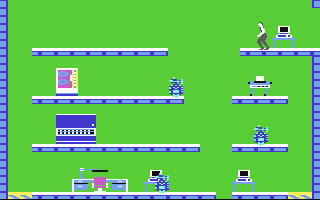We Salute You, Commodore!
It’s entirely possible that without Jack Tramiel, I might not have my current job.
Oh, sure, my first computer was a TI99/4A, but it was the family’s computer, and once we got the Intellivision I lost interest in the TI pretty quickly. The Commodore 64, on the other hand, was mine. It sat in my bedroom and, as such, 10-year-old me spent an awful lot of time with it.
 My dad and I got a subscription to Compute! Magazine, and later its sister publication, Compute!’s Gazette, and I spent hours typing in BASIC programs and object code line by line in order to run the games and utilities profiled in the magazine. Most of my middle school homework was typed using Compute!’s SpeedScript word processor, which was only 5KB in size (Microsoft Word for Mac 2011 by itself is about 60MB). One of the few times my older brother and I weren’t at each other’s throats was one Christmas Eve when my parents essentially locked us in my room and we played Dino Eggs and Micro League Baseball while they finished wrapping the gifts. It also provided my first exposure to porn, as one of my friends loaned me a very crude strip poker game. Low-resolution boobs were still boobs, after all.
My dad and I got a subscription to Compute! Magazine, and later its sister publication, Compute!’s Gazette, and I spent hours typing in BASIC programs and object code line by line in order to run the games and utilities profiled in the magazine. Most of my middle school homework was typed using Compute!’s SpeedScript word processor, which was only 5KB in size (Microsoft Word for Mac 2011 by itself is about 60MB). One of the few times my older brother and I weren’t at each other’s throats was one Christmas Eve when my parents essentially locked us in my room and we played Dino Eggs and Micro League Baseball while they finished wrapping the gifts. It also provided my first exposure to porn, as one of my friends loaned me a very crude strip poker game. Low-resolution boobs were still boobs, after all.
All of this (well, maybe not so much the strip poker game) fostered the love of computing that led me on the path to my paying job as a Unix administrator. While the C64 never had a Unix or Unix-like OS in my time (it was either Commodore BASIC, CP/M, or the graphical GEOS), the computer still did exactly what you told it to do. Or at least it tried to. Cryptic messages like “SYNTAX ERROR IN LINE 140” were common, especially when typing long BASIC programs by hand from dot-matrix printouts or magazine pages.
Ultimately, it was the logic of troubleshooting that appealed most to me and, while my father probably would have preferred me to be more mechanically inclined, he understood; the logic appealed to him, too. The difference was that my tools of choice weren’t covered in automotive grease or sawdust. What he loved about fixing cars or carpentry was what I loved about computing – there was an order to it. If you deviated from that ord er, what you were attempting to do might work, but it was more likely to fall apart on you.
er, what you were attempting to do might work, but it was more likely to fall apart on you.
After my mom went back to work when I was 10, I began to spend my summers at day camp. Unsurprisingly, I chose computer camp, learning Commodore BASIC on the C64 for half the morning, where my proudest achievement was a rudimentary parachute game with what passed for realistic wind effects at higher difficulties.
The other half of the morning was free time, where I amassed an impressive library of cracked games. We had a system at the camp – two machines were reserved for copying (ah, Fast Hack‘em III…), and the rest were used to play those same games we were copying. Summer Games. Commando. International Soccer. Spy vs. Spy. Impossible Mission. These games were far more advanced than what was available on the Intellivision or ColecoVision. Hell, Impossible Mission featured far more realistic speech than the IntelliVoice could provide and, nearly 30 years later, hearing that voice say “Destroy him, my robots!” still gives me chills. It made the text adventures on my uncle’s Apple II seem primitive, and it hooked me. I still launch the VICE C64 emulator and fire up those classic games just as much as I turn on my Intellivision II or launch Nesoid on my Android phone.
 When you look back at Jack Tramiel’s life, it’s amazing how he got to the point of developing the most popular home computer of the 1980s. He was imprisoned in Auschwitz as a boy after the Nazi invasion of his native Poland, where the notorious Dr. Josef Mengele examined him. Lucky to have survived World War II, he emigrated to the United States and joined the Army. He formed Commodore Business Machines in 1955 in order to import typewriters from Czechoslovakia into Canada. When the Japanese were able to undercut him, he switched to adding machines, but the Japanese undercut him there as well. He began making calculators, but eventually his primary supplier of integrated circuits, Texas Instruments, decided they wanted to get into the business themselves.
When you look back at Jack Tramiel’s life, it’s amazing how he got to the point of developing the most popular home computer of the 1980s. He was imprisoned in Auschwitz as a boy after the Nazi invasion of his native Poland, where the notorious Dr. Josef Mengele examined him. Lucky to have survived World War II, he emigrated to the United States and joined the Army. He formed Commodore Business Machines in 1955 in order to import typewriters from Czechoslovakia into Canada. When the Japanese were able to undercut him, he switched to adding machines, but the Japanese undercut him there as well. He began making calculators, but eventually his primary supplier of integrated circuits, Texas Instruments, decided they wanted to get into the business themselves.
Commodore bought MOS Technology, whose 6502 processor powered Commodore’s first computer, the PET. Born out of Commodore’s strikeouts with business machines, the success of the all-in-one PET (monochrome monitor, computer, and keyboard in one metallic case), especially in education, led to the development of the VIC-20 and C64 for the home. Tramiel himself said that he wanted to “build computers for the masses, not the classes.” And for 17 million households, that computer was the Commodore 64.
I salute you, Jack Tramiel. And a generation of computer nerds salutes you, too.
———
LOAD “@UnwinnableDonB”,8,1. Or if you have the Epyx FastLoad cartridge, hold down C= and press RUN/STOP.


